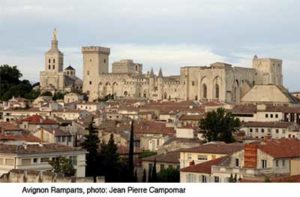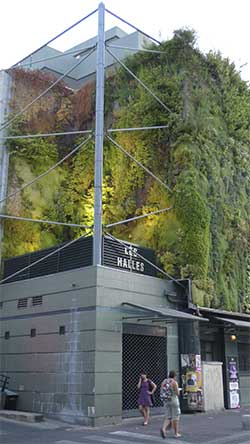 Paris offers enough diversity to satisfy the most demanding tastes, but it is also the best starting point from which to explore the rest of France and, indeed, of Europe. Starting a new series of suggestions of places interesting enough to justify a weekend trip, Martin Hills finds Avignon
Paris offers enough diversity to satisfy the most demanding tastes, but it is also the best starting point from which to explore the rest of France and, indeed, of Europe. Starting a new series of suggestions of places interesting enough to justify a weekend trip, Martin Hills finds Avignon
There are some ancient cities, like Carcassonne, that present themselves to the eye at a distance, making the observer feel part of some mediaeval dream. In fact, increasingly few of them, as urban sprawl shortens the vistas. One such is Avignon, which from most directions is first to be seen suddenly close up from the inner ring road, the abrupt appearance of ramparts dating from the 14th century always stunning, no matter how often you have already seen it.
Modern Avignon belies this mediaeval image. It is the prefecture of the Vaucluse department and so administrative centre for one of the most productive areas in the Provence-Côte d’Azur region. It is also the capital of an important agricultural area, the Comtat Venaissin. A little outside the centre is Agriparc, a vast and expanding permanent focus of research and development for all aspects of produce shared by government laboratories and many of the biggest names in the food industry. Adjacent to it is a new permanent exhibition, featuring interactive displays on all things agricultural, as well as cookery workshops and educational fun for the younger visitors. Finally, modern Avignon is active in the fields of chemicals, processed foods, ceramics and fertilisers.
 Avignon’s vertical garden. Photo: Jil ZimmermannHowever, important as they may be, these are not what brings the tourists in. Even the annual drama festival , now in its 65th year has, with its lively street theatre, a discernible echo of the pageants that filled the same places with crowds six centuries ago. So, while greater Avignon is a practical powerhouse of the present day, it is within the mediaeval battlements that the city’s special magic is to be found.
Avignon’s vertical garden. Photo: Jil ZimmermannHowever, important as they may be, these are not what brings the tourists in. Even the annual drama festival , now in its 65th year has, with its lively street theatre, a discernible echo of the pageants that filled the same places with crowds six centuries ago. So, while greater Avignon is a practical powerhouse of the present day, it is within the mediaeval battlements that the city’s special magic is to be found.
The initial impression that the old city is circular is misleading. It is more nearly rhomboid, like the calisson almond cakes of Aix-en-Provence. This distortion makes the Palais des Papes, the extraordinary building that was the centre of Roman Catholicism during a century of exile from Rome, and the nearby place de l’Horloge appear to be at the centre. It also helps to explain why going from there to the English bookshop, called Shakespeare like its Parisian namesake, most of the way towards the eastern ramparts, is more of a trek than you’d expect. Actually, the Papal Palace, a late arrival on the Doms Rock which has been settled by man since 4000BC, is so off-centre as to be quite close to the northern boundary.
The Palais des Papes is, of course, the principal tourist attraction in Avignon. Externally it is impressive, as are the Cathedral and other associated buildings, but its interior is so under-furnished (as are many of France’s historic edifices) that it is hard to visualise the rooms when populated by other than tourists. There are guides, human and printed, which help somewhat, although the latter (unless it has recently been revised) is more notable as a masterpiece of unintentional humour in its English version. Normally the tour of the palace is quite restricted in scope but now there are periodic evenings when visitors can see more of the rooms that are usually off limits.
The second most obvious ‘sight’ is the bridge of St Bénézet: the one on which people danced, according to the nursery rhyme; in fact, there was not room to swing a cat, let alone a partner, on the original footbridge itself and the dancing must really have happened sous le pont. For many years, the city fathers were quite sniffy about the old rhyme, presumably thinking it beneath their dignity. Today, in a complete reversal, they have taken it to their hearts and the now welcoming bridge even boasts its own ultra-modern recording studio. Here you can listen via tiny speakers in the walls to many of the different versions of the song. You can even play on the mixing console to put together different rhythms, images (still or video) and special effects. There is also a webcam so that you an make your own karaoke-style unique souvenir DVD recording of the sing for a very modest price. If you’re going to both palace and bridge, there is a discount combined ticket available.
The bridge originally consisted of 22 arches, spanning two arms of the Rhône which passed either side of a small island (perhaps the dancing venue?) to a distance of 900m between two guarded gatehouses. According to legend, it was first built in 1188, following a divine command heard by a shepherd boy. It had to be rebuilt in both the 13th and 15th centuries but almost half of the north- western end was washed away by floods in 15th century.
The place de l’Horloge, built on the Roman forum, is a lively spot with a finely-decorated 18th century carousel and an array of bars and restaurants spreading themselves across the square from buildings on the periphery. An interesting feature towards the north, or palace, end is the municipal theatre and opera house. On its side walls are trompe l’oeuil painted windows out of which lean some famous French artists. Once this was strikingly singular, but in recent years the notion has caught on and you are likely to find yourself repeatedly making double-takes at false windows all over the place.
There’s plenty more to see in Avignon and the municipality has helpfully divided the old city between four walking tours, each of which is clearly marked on pavement and by signs along the routes, full of information. Any of these, depending on your enthusiasm, could take up to three or four hours. As with old towns everywhere, the best advice is to keep looking upwards to see the buildings as they looked before the ground floors were converted to shops, offices and places to eat or drink.
One ‘sight’ that was still not highlighted during my most recent visit is the covered market on place Pie. This is, like most of its kind, an undistinguished building surmounted by a multi-storey car park. The mayor, hoping to cheer the place up, approached an eminent horticulturist for ideas. His proposal was remarkable: to erect a vertical garden covering almost the whole of the north face. Surprisingly enough, this proved feasible thanks to an ingenious method of plant-mounting combined with automatic fertilising and watering from reservoirs in the basement. The result is a wonderful living display whose colourful patterns keep changing from day to day throughout the year, Subsequently. other buildings, notably the new ethnicity museum on the quai Branly in Paris, have copied the idea, but Avignon’s market remains the first.
Avignon has a great variety of restaurants, from fast-food to gourmet, to choose from but, if the weather is kind during your stay, the outdoor tables on the place d’Horloge are worth trying, if only for the ambience created as the sun sets and the clear air shows the deep blue southern skies spangled with stars.
Bon voyage!

